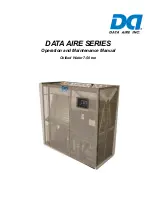
48
AFDK-SVU01C-EN
AFDK Pre-startup Checks
Motor Checks
1. Check the motor for proper horsepower and voltage
ratings. Verify that the motor full load amps do not
exceed the nameplate rating of the controller.
2. Check that the motor terminals are correctly connected
to the controller’s power terminals for the proper
voltage and motor rotation.
3. Use an ohmmeter to check for any short circuits
between the motor frame and the motor power leads.
If a short circuit exists, it must be corrected before
proceeding.
Controller Checks
1. Check that local, state and national electric codes have
been observed for the installation and wiring of this
equipment.
2. Check that all external power wiring has been properly
routed through the cabinet.
3. Check all input power and output power connections
for tightness.
4. Check the chassis ground and other connections for
tightness.
5. Check all external control connections (this includes
the operator station connections) for tightness.
WARNING
Hazardous Voltage w/Capacitors!
•
Disconnect all electric power, including remote
disconnects and discharge all motor start/run
capacitors before servicing. Follow proper lockout/
tagout procedures to ensure the power cannot be
inadvertently energized. For variable frequency
drives or other energy storing components provided
by Trane or others, refer to the appropriate
manufacturer’s literature for allowable waiting
periods for discharge of capacitors. Verify with an
appropriate voltmeter that all capacitors have
discharged.
If this equipment is interlocked with
other equipment, 115 volt ac may be present in the
cabinet even though the main power is
disconnected. If this is the case, these interlock
signals should be deactivated before any work is
performed on this equipment. Suitable warning tags
or disconnects should be added to these circuits and
all circuits should be tested before attempting to
energize or service the controller.
•
Each time power is removed, allow at least
10 minutes for dc units to discharge after power is
disconnected before servicing. Use extreme caution
when applying power. Equipment terminals and
other internal parts of the controller are at line
voltage when ac power is connected to the controller.
All ungrounded conductors of the ac power line must
be disconnected from the controller before it is safe
to touch any internal parts of this equipment.
Failure to disconnect power and discharge capacitors
before servicing could result in death or serious injury.
For additional information regarding the safe discharge of
capacitors, see PROD-SVB06A-EN
WARNING
Hazardous Service Procedures!
The maintenance and troubleshooting procedures
recommended in this section of the manual could result
in exposure to electrical, mechanical or other potential
safety hazards. Always refer to the safety warnings
provided throughout this manual concerning these
procedures. When possible, disconnect all electrical
power including remote disconnects before servicing.
Follow proper lockout/tagout procedures to ensure the
power can not be inadvertently energized. When
necessary to work with live electrical components, have
a qualified licensed electrician or other individual who
has been trained in handling live electrical components
perform these tasks. Failure to follow all of the
recommended safety warnings provided, could result in
death or serious injury.
WARNING
Proper Field Wiring and Grounding
Required!
All field wiring MUST be performed by qualified
personnel. Improperly installed and grounded field
wiring poses FIRE and ELECTROCUTION hazards. To
avoid these hazards, you MUST follow requirements for
field wiring installation and grounding as described in
NEC and your local/state electrical codes. Failure to
follow code could result in death or serious injury.
NOTICE
Do Not Megohm Test!
Do not use a megger to perform continuity checks in
the drive equipment. Failure to follow the above
precaution could cause damage to the controller
circuitry.
NOTICE
Disconnect Motor Leads!
Disconnect all motor leads prior to megging the motor.
Failure to do so could cause equipment damage.













































